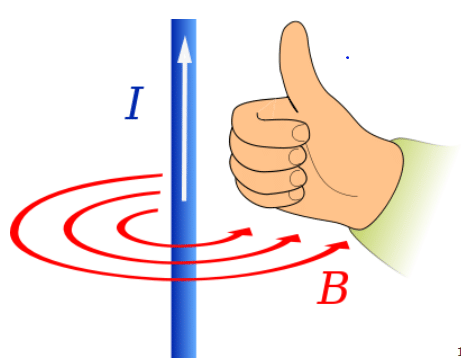Class 10 Exam > Class 10 Notes > Science Class 10 > Theory & Procedure, Magnetic field lines around current carrying conductor
Theory & Procedure, Magnetic field lines around current carrying conductor | Science Class 10 PDF Download
Objective:
To observe the magnetic field lines around current carrying conductor.
Theory:
- Magnetic effect of electric current is one of the major effects of electric current in use, without the applications of which we cannot have motors in the existing world.
- A current carrying conductor creates a magnetic field around it, which can be comprehended by using magnetic lines of force or magnetic field lines.
- The nature of the magnetic field lines around a straight current carrying conductor is concentric circles with centre at the axis of the conductor.
- The strength of the magnetic field created depends on the current through the conductor.
- The direction of the magnetic field lines of force around a conductor is given by the Maxwell’s right hand grip rule or the right handed corkscrew rule. Imagine that you are holding a current-carrying straight conductor in your right hand such that the thumb points towards the direction of current. Then your fingers will wrap around the conductor in the direction of the field lines of the magnetic field (See Fig.1). This is known as right hand thumb rule.

Fig 1 - Right hand thumb rule.
As performed in the real lab
Apparatus:
A battery (12 V), a variable resistance (or a rheostat), an ammeter (0–5 A), a plug key, and a long straight thick copper wire.
Procedure:
- Fix the cardboard and insert the wire through the centre of cardboard such that it is normal to its plane.
- Connect the wire with rheostat, ammeter, battery and plug key in series.
- Sprinkle the iron filings uniformly on the cardboard.
- Keep the variable of the rheostat at a fixed position and note the current through the ammeter.
- Close the key and gently tap the cardboard.
- Observe the pattern of the iron filings over the cardboard.
As performed in the simulator
- Adjust the current flowing from the conductor and distance of the object from the conductor using the sliders from the Controls section.
- Note the direction of the magnetic field and also the direction of current flowing through the conductor.
- Also, note the magnetic field (B) acting on the object O.
- Click on "Change Current Direction" checkbox, to change the direction of current.
- Click on "Observations " tab below to view the observation.
Observations
- You will observe that the magnetic field lines are formed in concentric circles around the current carrying conductor. These lines do not intersect each other and are equidistant from each other.
- The direction of the field is perpendicular to the conductor.
- The magnetic field (B) acting on the object O increases as the current flowing through it increases.
- The field increases as object O is closer to the conductor and decreases as it moves away from the conductor.
- The direction of magnetic field lines gets reversed if the direction of current is reversed.
The document Theory & Procedure, Magnetic field lines around current carrying conductor | Science Class 10 is a part of the Class 10 Course Science Class 10.
All you need of Class 10 at this link: Class 10
|
80 videos|569 docs|80 tests
|
FAQs on Theory & Procedure, Magnetic field lines around current carrying conductor - Science Class 10
| 1. What are magnetic field lines? |  |
Ans. Magnetic field lines are imaginary lines used to represent the direction and strength of the magnetic field around a current carrying conductor. They provide a visual representation of the magnetic field.
| 2. How are magnetic field lines formed around a current carrying conductor? |  |
Ans. Magnetic field lines are formed around a current carrying conductor due to the flow of electric current. The magnetic field lines form concentric circles around the conductor, with the direction of the field lines determined by the right-hand rule.
| 3. How does the strength of the magnetic field vary with the distance from the current carrying conductor? |  |
Ans. The strength of the magnetic field decreases with increasing distance from the current carrying conductor. The magnetic field strength follows an inverse square law, which means that it decreases rapidly as you move away from the conductor.
| 4. Can the magnetic field lines be affected by the shape of the current carrying conductor? |  |
Ans. Yes, the shape of the current carrying conductor can affect the shape of the magnetic field lines. For example, if the conductor is in the form of a loop or a coil, the magnetic field lines will be concentrated within the loop or coil, creating a stronger magnetic field.
| 5. How can the magnetic field lines around a current carrying conductor be used practically? |  |
Ans. The magnetic field lines around a current carrying conductor have various practical applications. They are used in devices such as electromagnets, electric motors, and transformers. Understanding the pattern of magnetic field lines helps engineers design and optimize these devices for specific applications.
Related Searches





















